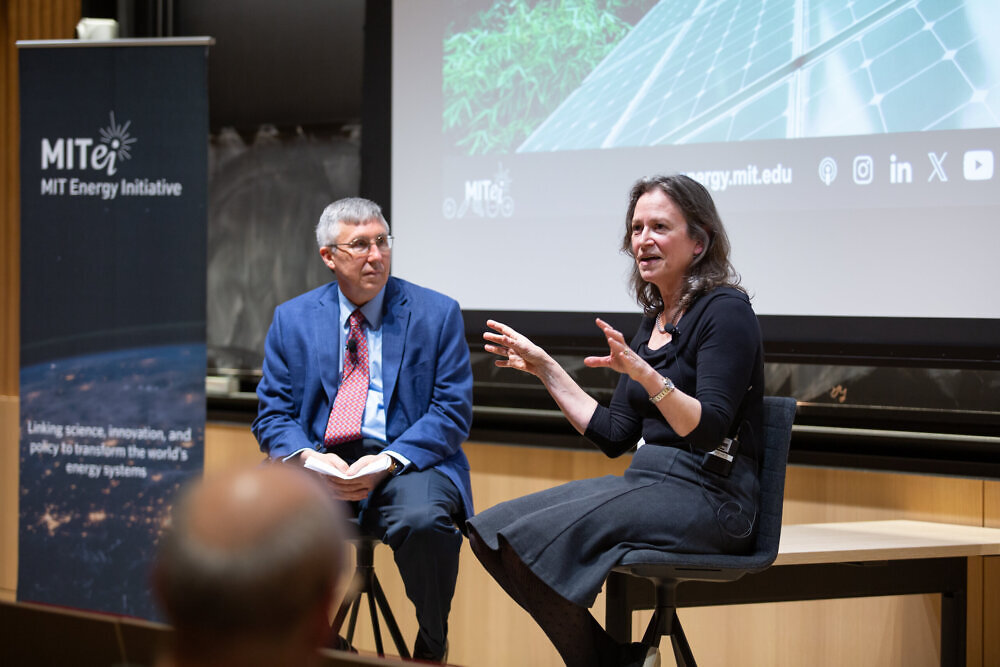
Kelley Travers
As the frequency and seriousness of severe weather condition occasions expand, it might become significantly needed to use a bolder strategy to climate change, cautioned Emily A. Carter, the Gerhard R. Andlinger Teacher in Energy and the Environment at Princeton College. Carter made her case for why the power transition is no more enough despite environment modification while speaking at the MITEI Provides: Progressing the Power Change seminar.
“If all we do is look after what we did in the past– however we do not alter what we do in the future– then we’re still going to be entrusted to extremely major issues,” she stated. Our strategy to environment adjustment reduction have to consist of makeover, treatment, and adaption approaches, claimed Carter.
Transitioning to a decarbonized electrical energy system is one piece of the puzzle. Expanding amounts of solar and wind power– together with nuclear, hydropower, and geothermal– are slowly transforming the power electrical power landscape, but Carter kept in mind that there are brand-new technologies further down the pipeline.
“Advanced geothermal may come on in the following couple of decades. Combination will only truly begin to contribute later in the century, yet might provide strong power such that we can start to decommission nuclear,” stated Carter, that is likewise an elderly critical consultant and associate research laboratory director at the Department of Energy’s Princeton Plasma Physics Lab.
Taking this an action even more, Carter described exactly how this carbon-free electricity must after that be used to electrify every little thing we can. She highlighted the commercial market as a critical area for change: “The power change is about transitioning off of nonrenewable fuel sources. If you check out the manufacturing industries, they are driven by fossil fuels now. They are driven by fossil fuel-driven thermal procedures.” Carter noted that thermal power is a lot less effective than power and highlighted electricity-driven techniques that could replace warm in production, such as electrolysis, plasmas, light-emitting diodes (LEDs) for photocatalysis, and joule heating.
The transport sector is also a key location for electrification, Carter stated. While electric vehicles have become increasingly usual over the last few years, sturdy transport is not as conveniently amazed. The remedy? “Carbon-neutral gas for sturdy aviation and shipping,” she stated, emphasizing that these fuels will certainly need to enter into the circular economic climate. “We know that when we melt those fuels, they’re going to generate CO 2 [carbon dioxide] once again. They need to find from a resource of CO 2 that is not fossil-based.”
The following action is intervention in the type of co2 removal, which after that requires techniques of storage and use, according to Carter. “There’s a great deal of discuss building lots of pipes to record the carbon monoxide 2 — from fossil fuel-driven power plants, concrete plants, steel plants, all kind of commercial areas that send out carbon monoxide 2 — and afterwards piping it and keeping it underground,” she clarified. Offshore pipes are much more costly than those ashore, yet can minimize public worries over their safety. Europe is exclusively focusing their efforts offshore for this extremely factor, and the very same might be real for the USA, Carter stated.
Once co2 is captured, commercial use may provide economic leverage to increase sequestration, even if just a few gigatons are used each year, Carter kept in mind. Via mineralization, CARBON MONOXIDE 2 can be converted into carbonates, which can be utilized in building products such as concrete, and road-paving materials.
There is another form of intervention that Carter presently views as a last resort: solar geoengineering, occasionally referred to as solar radiation management (SRM). In 1991, Mount Pinatubo in the Philippines emerged and launched sulfur dioxide into the stratosphere, which created a short-lived cooling of the Earth by ~ 0. 5 ° C for over a year. SRM seeks to recreate that cooling impact by infusing particles into the atmosphere that mirror sunlight. According to Carter, there are three main strategies: dizzying aerosol shot, cirrus cloud thinning (thinning clouds to let more infrared radiation sent out by the planet retreat to area), and aquatic cloud lightening up (lightening up clouds with sea salt so they reflect more light).
“My sight is I wish we don’t ever have to do it, but I sure assume we should recognize what would certainly take place in situation somebody else just chooses to do it. It’s a worldwide safety issue,” claimed Carter. “In principle, it’s not so challenging technically, so we want to really recognize and to be able to forecast what would certainly take place if that happened.”
With any innovation, stakeholder and area involvement is essential for deployment, Carter claimed. She emphasized the significance of both respectfully paying attention to problems and extensively resolving them, mentioning, “With any luck, there’s enough info provided to relieve their fears. We need to obtain the trust of people prior to any release can be considered.”
An essential part of this trust fund begins with the obligation of the clinical neighborhood to be transparent and review each other’s job, Carter stated. “Skepticism is excellent. You ought to need to confirm your proof of principle.”
MITEI Offers: Progressing the Energy Transition is an MIT Energy Campaign audio speaker series highlighting power experts and leaders at the leading edge of the clinical, technical, and plan remedies needed to change our energy systems. The series will proceed in Loss 2025 For more information on this and extra events, check out: energy.mit.edu/events/